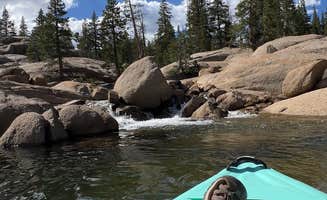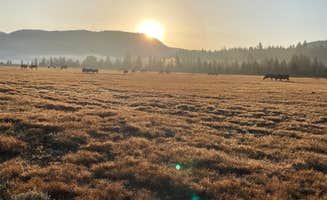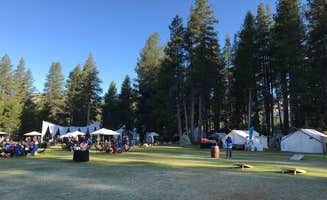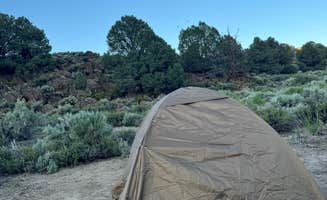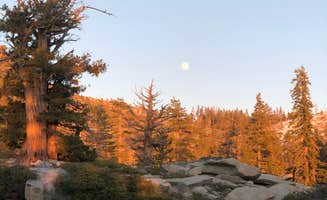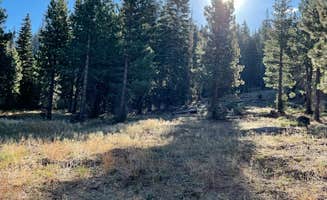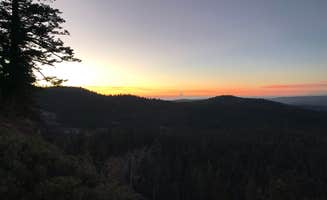Dispersed camping areas near Coleville, California offer primitive camping opportunities on public lands at elevations ranging from 5,000 to 8,300 feet. The Eastern Sierra region features dramatic alpine terrain with significant temperature variations—summer days can exceed 90°F while nights drop below 50°F even in July and August. Most dispersed sites sit on U.S. Forest Service or Bureau of Land Management land with 14-day stay limits.
What to do
Hot springs soaking: 10-15 minute walk from Bridgeport Travertine Hot Springs Dispersed campsites to natural thermal pools. "Stargazing from the hot springs was awesome!" reports Nick O. The springs offer multiple pools of varying temperatures with mountain views.
Mountain lakes access: 2-mile drive from Leavitt Lake camping area to trailheads. "When we arrived, there were at least 7 other groups there. Location is beautiful and will definitely return in the future," shares Jeff L. The area connects to multiple high-elevation alpine lakes.
Off-roading: Several 4x4 trails near Scotts Lake Rd Dispersed Camping. "We went just up the road into the wildlife reserve and drove all the way up to burnside lake. Beautiful. Definitely need 4x4 and the road is super bumpy," explains Blair K. Many routes require high-clearance vehicles.
What campers like
Solitude and space: Dispersed sites on forest roads often provide distance between campers. "We had a wildflower-filled meadow to ourselves in early August with plenty of near-by trails for dirt bikes, Jeeping, horses, mountain biking or hiking," notes Ken J. about camping along Blue Lakes Rd.
Night sky viewing: The high desert location offers exceptional astronomy opportunities. "Perfect spot for star gazing!! We arrived when it was dark and had no problem finding a spot! It was open with plenty of spots & we were the only ones!" explains Josie H. about Bear Valley Dispersed Camping.
Natural hot springs: Multiple thermal areas within short distances of camp. "Really great spot - please come prepared to deal with all trash/human waste needs. We were thrilled with the level of user stewardship. Impressive," shares Shane C. about Travertine Hot Springs.
What you should know
Road conditions vary significantly: Many roads require high-clearance vehicles, especially after weather events. "I have a truck. I got about a half mile in before the snow washed out the road. You can still hike in. High clearance and 4wd a must," warns Val C. about Leavitt Lake access.
Fire restrictions change seasonally: Rules differ based on conditions and location. "You are allowed to camp on the road to the hot springs, there are several pull outs making it easy however there is no camping past a certain point (signs stating) and not at the springs," explains Samantha T. about Buckeye Hot Springs.
Cell service inconsistent: Reception varies by location and carrier. "This is full wilderness camping off the main road between hope valley and the blue lakes. I had no problem getting in with my 30ft bus towing a jeep but the road is steep and winding for about 7 miles to the pull off," notes Jacqueline G., adding, "The Blue Lakes are just down the road for swimming, boating, kayaking etc."
Tips for camping with families
Choose established clearings: Look for flat areas with natural wind protection. "The ground is very flat and many areas are paved with gravel. At 7500 feet above sea level, the view is wide and the scenery is beautiful, especially the sunset view," says Leo Y. about Iron MT. Dispersed camping.
Pack for temperature swings: Bring warm clothing even in summer. "Wooded campground, cool weather, good phone reception, many spots taken with no activity probably by locals. Lake, hiking, close shopping," notes DJ M. about Bear Valley camping conditions.
Plan water supply carefully: No potable water at most sites. "Bear valley is my favorite place to go camping, the most you get close to the top of the mountain, the most curvy the road is, so be prepare. There is a point where the paved road disappears and is only dirt road," advises Claudia M.
Tips from RVers
Size limitations apply: Most dispersed areas accommodate smaller rigs only. "We are new to dispersed camping and have a 40 ft 5th wheel as well as a GMC Denali 350 dually. We need a large space to fit into. We arrived on a Monday at noon and found that the large area about 1/4 mile in was not at all crowded," shares Susan L. about Hope Valley Dispersed camping.
Prepare for steep terrain: The mountainous region features significant elevation changes. "There are prolonged climbs to get here (up to about 8% grade) but my bus did fine. Slow and steady and you'll be fine. Also WATCH THE WEATHER! Rain can cause spots of the road in to get washed out a bit and deep puddles can appear," advises Jacqueline G.
Consider weekday arrival: Popular areas fill quickly on weekends. "Great place if you're self contained. Great view, space between sites," comments Don D. about dispersed camping options along Blue Lakes Road, where weekday arrivals typically find more available space.




